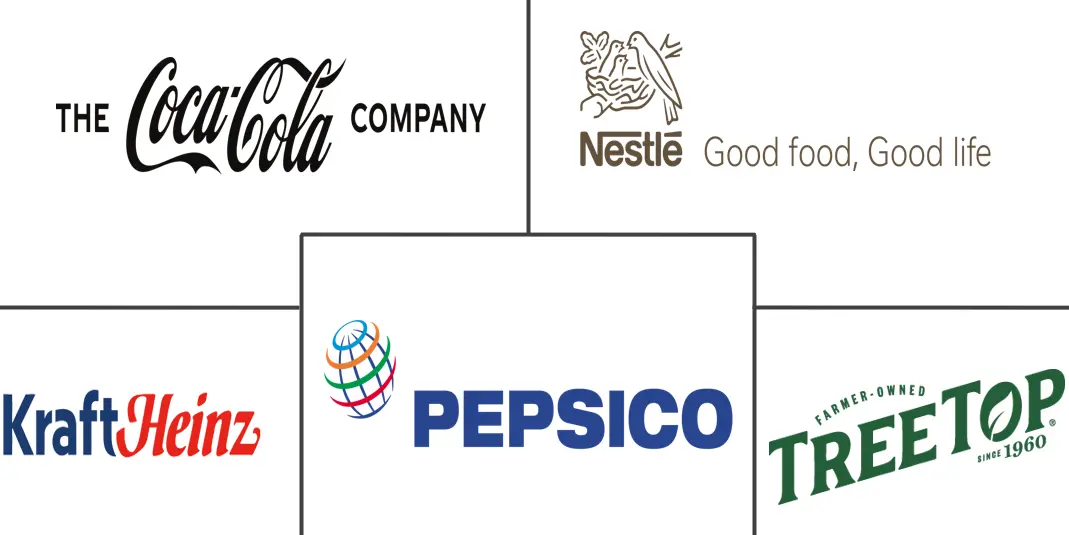Apple Juice Market Size and Share
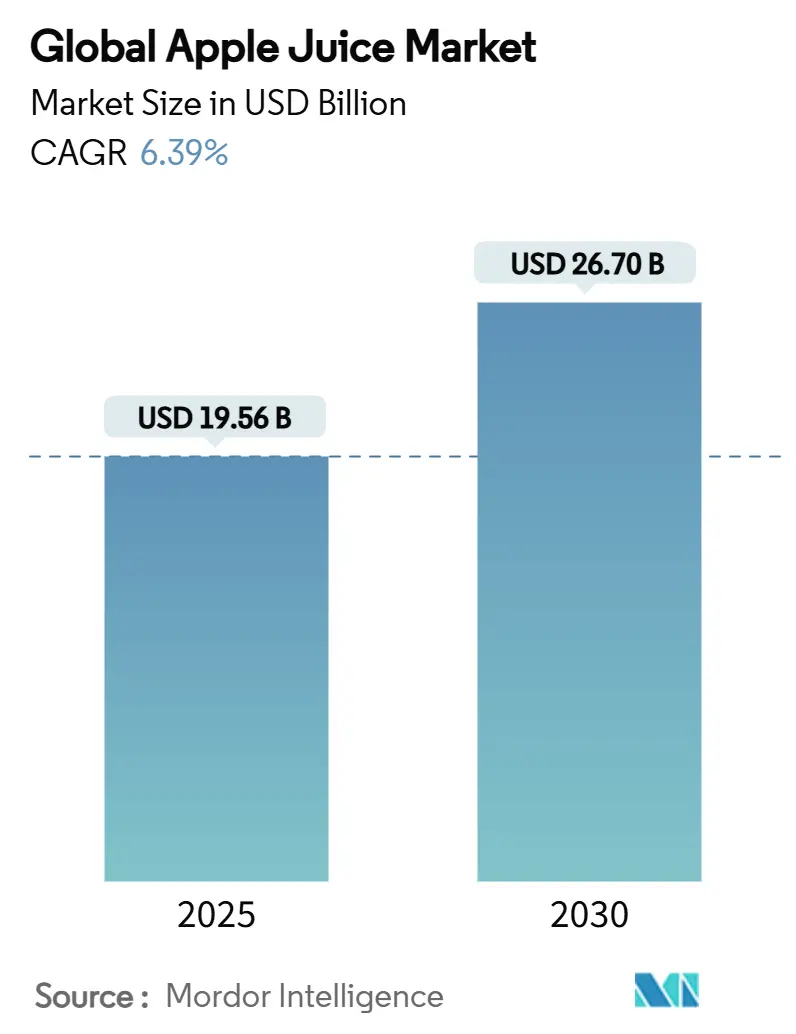
Apple Juice Market Analysis by Mordor Intelligence
The apple juice market size stands at USD 19.56 billion in 2025 and is projected to reach USD 26.7 billion by 2030, advancing at a 6.39% CAGR over the forecast period. This performance places the apple juice market at the intersection of indulgent refreshment and functional nutrition, as brand owners add probiotics, vitamins, and fiber concentrates to elevate health credentials. Concentrate continues to anchor international trade flows because of shelf-life advantages, yet not-from-concentrate (NFC) variants capture premium demand in developed cities. Western consumers gravitate toward organic and reduced-sugar recipes, while urbanizing Asian populations sustain volume growth through affordable mainstream SKUs. Technology adoption—ranging from ultrasonic pasteurization to suspension freeze concentration—allows processors to protect polyphenols and extend chilled storage, reinforcing value creation opportunities. Key headwinds stem from crop-supply shocks, tariff volatility, and mounting regulatory scrutiny of heavy-metal residues and intrinsic sugar levels. Nevertheless, the apple juice market demonstrates resilience as vertically integrated suppliers hedge raw-material risk, diversify orchard bases, and convert waste pomace into pectin or biofuel streams that improve margin security. Sustainability mandates and cleaner labels are accelerating carton- and pouch-format innovation, enabling brands to communicate carbon reductions while improving convenience.
Key Report Takeaways
- By product type, concentrate retained 63.20% of 2024 revenue, while NFC is poised for a 7.30% CAGR to 2030.
- By nature, conventional products held 89.70% of 2024 consumption; the organic segment is expanding at 8.90% to 2030.
- By packaging type, aseptic cartons delivered 42.00% share in 2024; pouches lead growth at an 8.12% CAGR.
- By distribution channel, retail commanded 72.30% of the apple juice market share in 2024, whereas foodservice/HoReCa is rising at 7.10% through 2030.
- By geography, North America contributed 38.40% revenue in 2024; Asia-Pacific is the fastest-growing region at a 6.30% CAGR to 2030.
Global Apple Juice Market Trends and Insights
Driver Impact Analysis
| Driver | (~) % Impact on CAGR Forecast | Geographic Relevance | Impact Timeline |
|---|---|---|---|
| Health and Wellness Trends | +1.2% | Global, with the strongest impact in North America & Europe | Medium term (2-4 years) |
| Growth in Demand for Functional and Fortified Juices | +0.8% | Asia-Pacific core, spill-over to North America | Long term (≥ 4 years) |
| Shift Toward Organic and Clean-Label Products | +0.6% | North America & EU, expanding to APAC | Medium term (2-4 years) |
| Product Innovation and Flavor Variety | +0.5% | Global, with early adoption in developed markets | Short term (≤ 2 years) |
| Popularity of Plant-Based and Flexitarian Diets | +0.4% | North America & Europe, emerging in urban APAC | Medium term (2-4 years) |
| Sustainability and Environmental Concerns | +0.3% | EU leading, followed by North America | Long term (≥ 4 years) |
| Source: Mordor Intelligence | |||
Health and wellness trends
Global apple juice market trends are increasingly influenced by health and wellness considerations, reshaping both consumer choices and industry innovations. Responding to governmental and organizational pushes for reduced sugar intake, functional nutrition, and transparent labeling, apple juice producers are rolling out cleaner formulations and enhanced product variants. Highlighting this shift, the International Food Information Council noted that over 62% of North American consumers now gravitate towards health-beneficial beverages. This trend has catalyzed a rise in popularity for cold-pressed, organic, and no-added-sugar apple juice offerings. Echoing this sentiment, brands like Evolution Fresh, in late 2024 and extending into 2025, unveiled an organic apple juice blend, infused with functional ingredients and adhering to USDA-organic standards. Simultaneously, Lakewood Organic introduced a premium cold-pressed juice subscription service, sourced directly from farms. Coupled with burgeoning demand in emerging markets and a robust e-commerce distribution network, apple juice is evolving from a mere refreshment to a recognized health-centric beverage.
Growth in demand for functional and fortified juices
In 2024, health-conscious consumers increasingly gravitated towards beverages fortified with vitamins, minerals, probiotics, and antioxidants. Apple juice has emerged as a versatile base for these innovations. Organizations such as the International Food Information Council and various government-sponsored health campaigns highlight that over 60% of consumers are now on the lookout for functional beverages that bolster immunity, promote gut health, and enhance overall wellness. Responding to this trend, apple juice brands rolled out a series of fortified, clean-label formulations in 2024–2025. These include cold-pressed juices enriched with probiotics and fiber, as well as blends featuring superfruit extracts like ginger and blueberry, specifically designed for digestive and antioxidant benefits. Trader Joe’s, recognizing the shift towards minimally processed, nutrient-rich juices, reintroduced its Organic Unfiltered Apple Juice in February 2025. Additionally, 2024 saw the debut of spiral-filter press methods in cold-pressed innovations, designed to maximize the retention of flavan-3-ols and vitamin C, both of which are known to support cardiovascular health.
Shift toward organic and clean-label products
As consumers and regulators increasingly prioritize transparency, purity, and sustainable production, the global apple juice market is undergoing a significant transformation, leaning towards organic and clean-label offerings. Governments and associations are actively supporting this movement. For example, the USDA's "Strengthening Organic Enforcement" rule, set to take effect in February 2025, aims to tighten certification oversight, curbing fraudulent claims and bolstering trust in organic labeling. Highlighting the trend, as of December 2024, the Bundesanstalt für Landwirtschaft und Ernährung reported that Germany had certified approximately 4,262 organic non-alcoholic beverages, including apple juice[1]Bundesanstalt für Landwirtschaft und Ernährung, "Development of product advertisements for the use of the organic seal, Quarter-4, 2024", www.oekolandbau.de. In the U.S., organic beverage consumption saw a rise from USD 2.64 billion in 2023 to USD 2.72 billion in 2024, as noted by the Organic Trade Association[2]Organic Trade Association," Consumption value of organic beverages in the United States", www.globalorganictrade.com. Additionally, trade groups such as the Juice Products Association and the International Fruit & Vegetable Juice Association (IFU) are pushing for clearer standards on ingredient sourcing, minimal processing, and transparent labeling, further boosting consumer confidence and driving market growth.
Product innovation and flavor variety
Product innovation and a push for diverse flavors are reshaping the global apple juice market, transforming it from a traditional beverage into a canvas for premium, playful, and functional experiences. Reports indicate that consumers, particularly Gen Z, are gravitating towards unique flavor fusions, leading to the rise of apple juice blends infused with spices, superfruits, and even savory undertones. Surveys from entities like the International Fruit & Vegetable Juice Association underscore a growing appetite for inventive juice formats that prioritize both taste and wellness. In 2024–2025, major brands responded with a slew of innovative offerings: 7‑Eleven unveiled its seasonal Caramel Apple “Replenish” drink in late 2024, capturing the essence of autumn. In April 2024, Keurig Dr Pepper’s Mott’s rolled out Mott’s Active, a blend of apple juice, coconut water, and electrolytes, targeting hydration for kids without added sugars. Meanwhile, Trader Joe’s Organic Unfiltered Apple Juice made a comeback in February 2025, catering to the demand for a craft-style flavor and texture. These initiatives, ranging from flavor experimentation to functional enhancements, highlight the apple juice market's evolution, appealing to both adventurous consumers and health-conscious buyers.
Restrains Impact Analysis
| Restraint | (~) % Impact on CAGR Forecast | Geographic Relevance | Impact Timeline |
|---|---|---|---|
| Raw Material Availability and Supply Chain Disruptions | -0.7% | Global, with acute impact in import-dependent regions | Short term (≤ 2 years) |
| Competition from Alternative Beverages | -0.5% | North America & Europe, expanding globally | Medium term (2-4 years) |
| Perceptions about Sugar Content | -0.4% | Global, strongest in health-conscious markets | Medium term (2-4 years) |
| Shelf Life and Spoilage Issues | -0.3% | Emerging markets with limited cold chain infrastructure | Long term (≥ 4 years) |
| Source: Mordor Intelligence | |||
Competition from alternative beverages
As consumers increasingly gravitate towards beverages boasting lower sugar content, enhanced functional benefits, and unique flavor profiles, the global apple juice market finds itself under mounting pressure. Recent dietary guidelines, notably from the U.S. Department of Agriculture, advocate for reduced sugary beverage consumption. This has spurred consumers to turn to alternatives like other fruit juices, kombucha, infused waters, and plant-based milks, often touted as healthier and more innovative. For instance, according to the US Department of Agriculture, in 2022/2023, the U.S. consumption of orange juice amounted to about 2.41 gallons per capita. Responding to these evolving tastes, the industry has seen notable product innovations: In 2024, GreenLeaf Beverages rolled out a range of plant-based “superfruit infusions,” merging apple juice with functional ingredients. Following suit, NutriSip debuted a fortified almond-oat juice blend in early 2025, targeting health-conscious consumers in search of nutrients beyond traditional fruit juices. These shifts highlight the hurdles for conventional apple juice products. Not only do they face competition from a diverse range of low-sugar, nutrient-rich beverages, but they also grapple with the need to tweak their formulations and marketing to keep pace with a shifting consumer base.
Raw-material availability and supply-chain disruptions
Global apple juice production has grappled with raw material shortages and supply chain disruptions, significantly hampering its growth. Climatic fluctuations and labor shortages have led to diminished apple yields in key growing regions. In 2023, Europe experienced a 4% dip in production. Concurrently, countries like Poland, Hungary, Turkey, and the Czech Republic reported subpar blossom conditions, further curtailing their processing supplies. TurkStat data reveals a drop in Turkey's apple production from 4.6 megatons to 4.4 megatons in 2024[3]Ministry of Agriculture and Forestry, "Crop Production Statistics, 2024", data.tuik.gov.tr. In the U.S., apple growers contended with a 2% production decline in the 2024–25 crop year, attributed to soaring labor and input costs. Notably, labor constituted roughly 60% of these production expenses, squeezing processors' profit margins. Trade disruptions, highlighted by the 2025 U.S. tariffs on Chinese apple concentrate, coupled with a reliance on imports, have led to a staggering 33% surge in wholesale concentrate prices. This price hike has forced companies to seek alternative suppliers, notably in Turkey. The confluence of limited supply and rising costs has challenged apple juice manufacturers, resulting in production shortages, inflated consumer prices, and ultimately, stunted market growth.
Segment Analysis
By Product Type: Concentrate Dominance Faces NFC Innovation
Concentrate controlled 63.20% of 2024 revenue, underlining its role in global trade and cost-efficient formulation, while the not-from-concentrate tier, however, registers a 7.30% CAGR to 2030. Concentrates are simple to ship, store, and use as ingredients in blended drinks or baby foods at scale. By removing most of the water content from fresh juice, producers significantly reduce volume and weight, which in turn lowers transportation and storage costs, making CAJ a staple in both industrial use and emerging market distribution. Moreover, the U.S. Department of Agriculture noted that over 70% of apple juice consumed in the U.S. is derived from Chinese concentrate, creating both dependency and price sensitivity to trade tariffs and climate conditions abroad. In 2024 and 2025, these dynamics are reflected in product innovation: concentrate producers are expanding into powdered concentrates, such as Coca‑Cola India’s Minute Maid Apple Sparkle, launched in 2024, leveraging local sourcing and convenience.
In contrast, the not-from-concentrate (NFC) segment is the fastest-growing, propelled by rising health consciousness: NFC retains more natural flavor, nutrients, and antioxidants, making it attractive to wellness-focused consumers. NFC apple juice brands are enhancing premium offerings: glass-bottled, minimally processed apple NFC juices are gaining traction in North America and Europe, with carton packaging supporting freshness and convenience. Moreover, as producers, certain companies are blending functional ingredients into NFC apple juice (e.g., botanicals, probiotics) to meet clean-label and wellness expectations. Thus, while concentrate remains dominant for industrial and cost reasons, NFC is outpacing it in growth, shaping the market's two-tier structure.
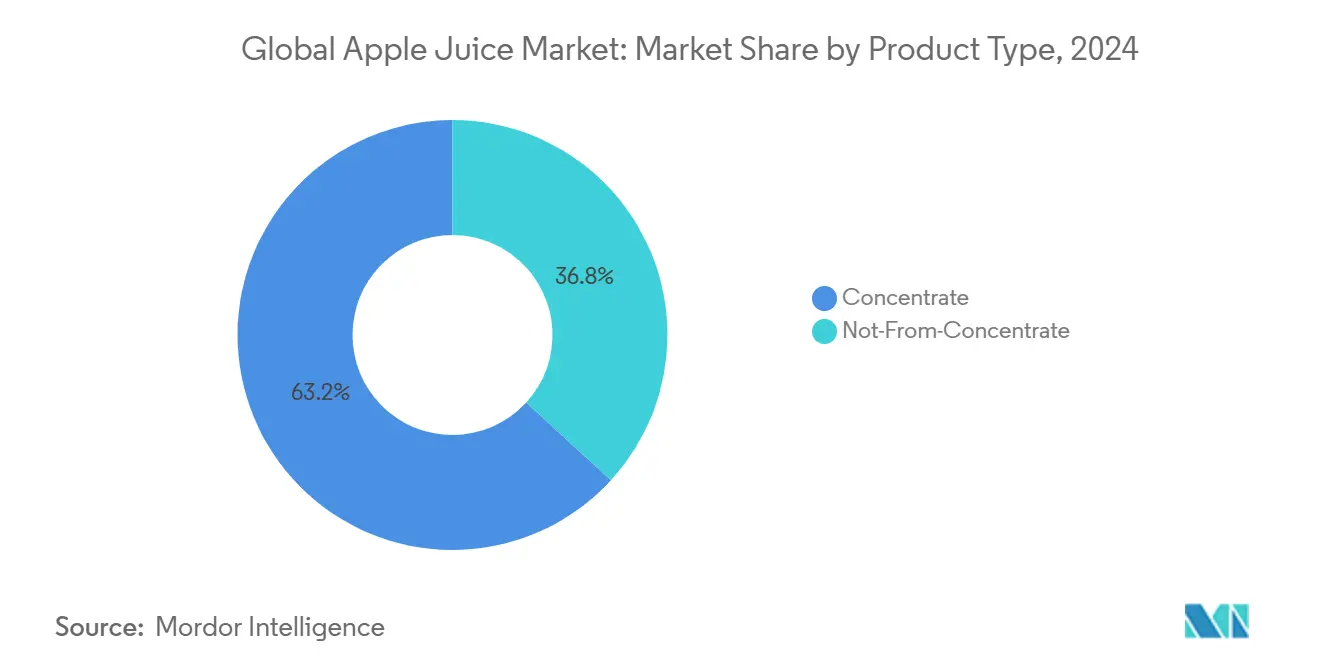
By Nature: Organic Growth Accelerates Despite Conventional Dominance
In 2024, conventional juice dominated the market with an 89.70% share, buoyed by advantages like cost-effectiveness, extended shelf life, economies of scale, efficient processing, and a broad distribution network. On the other hand, the organic segment, capturing 8.90% of the market, highlights a growing trend among affluent consumers leaning towards pesticide-free and sustainable choices. At the same time, stringent certification standards bind organic apple juice and often face regional supply constraints, while conventional apple juice benefits from diverse cultivation and processing methods. These methods not only curtail production costs but also amplify yields. Such advantages render conventional apple juice the preferred option for foodservice channels, value-driven retailers, and institutional buyers. For instance, according to the USDA, over 90% of apple juice imported into the U.S. is derived from conventional concentrate, primarily sourced from China, due to competitive pricing and stable supply chains.
The organic apple juice segment is witnessing growth, fueled by a surging demand for healthier and environmentally sustainable products. In 2024, organic beverage consumption in South Korea hit 14.8 million, a rise from 14 million in 2023 (Global Organic Trade Guide). Recent innovations spotlight Simply Organic's premium cold-pressed organic apple juice, crafted from single-origin apples and housed in freshness-preserving glass packaging. Martinelli's has also expanded its organic range, bolstered by an enhanced cold-chain distribution and direct-to-consumer shipping. Such strides resonate with the escalating preference for organic and clean-label products.
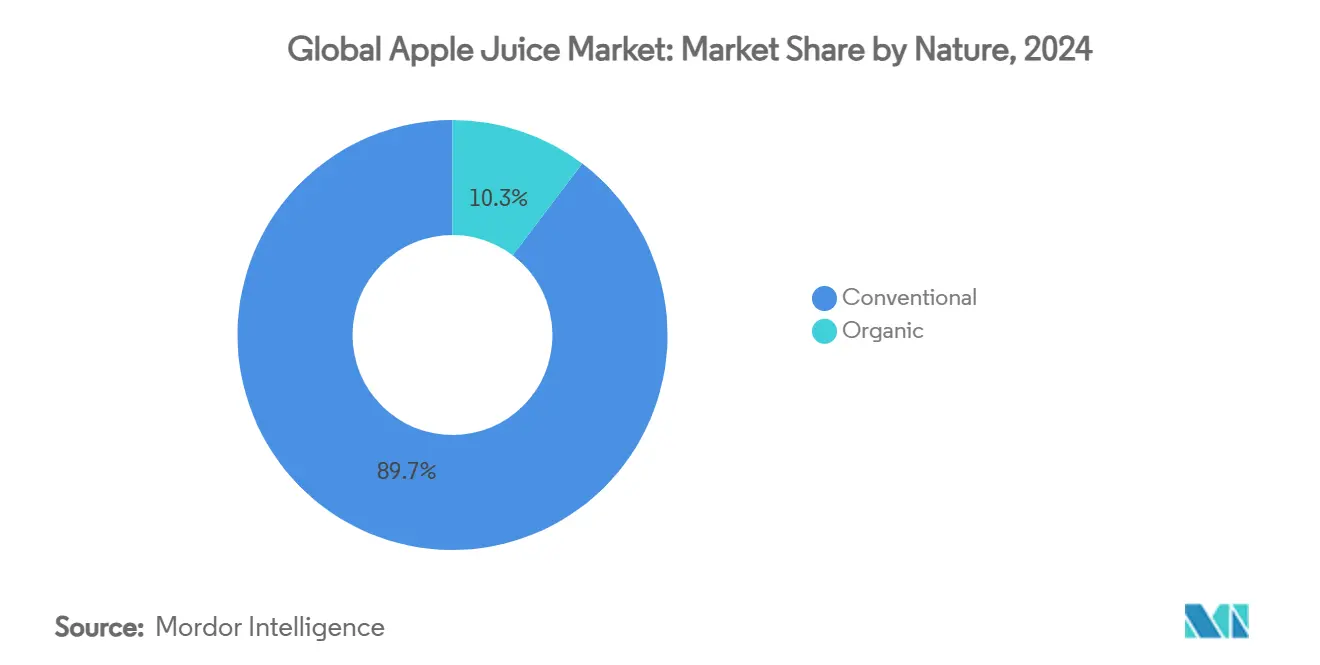
By Packaging Type: Sustainable Innovation Drives Pouches Growth
In 2024, aseptic cartons captured 42.00% of the global revenue, while flexible pouches surged with an 8.12% CAGR. Aseptic carton packaging, lauded for its shelf stability, cost efficiency, and robust barrier protection, has garnered endorsements from both government and industry standards. This endorsement has propelled the widespread adoption of aseptic cartons. Leading suppliers, including Tetra Pak and SIG Combibloc, have spearheaded innovations, unveiling fully recyclable aseptic cartons in 2024, in response to tightening sustainability policies and rising consumer demand.
While cartons have traditionally held the reins, the pouch segment is emerging as the frontrunner, celebrated for its lightweight, portable, and often resealable nature. Reflecting this trend, innovators rolled out biodegradable and compostable pouch formats in 2024–2025. Noteworthy examples include Mondi Group’s biodegradable pouches launched in July 2024. Convenience brands, such as Capri‑Sun, have further cemented the pouch's popularity, boasting annual sales of around 6 billion. The economic advantage of pouches, coupled with their convenience, resonates with regulatory pushes for sustainable and spill-proof formats, especially in school meals and public vending. Consequently, while aseptic cartons maintain their foothold in mainstream and long-shelf applications, the swift rise of flexible pouches is redefining the growth trajectory in apple juice packaging.
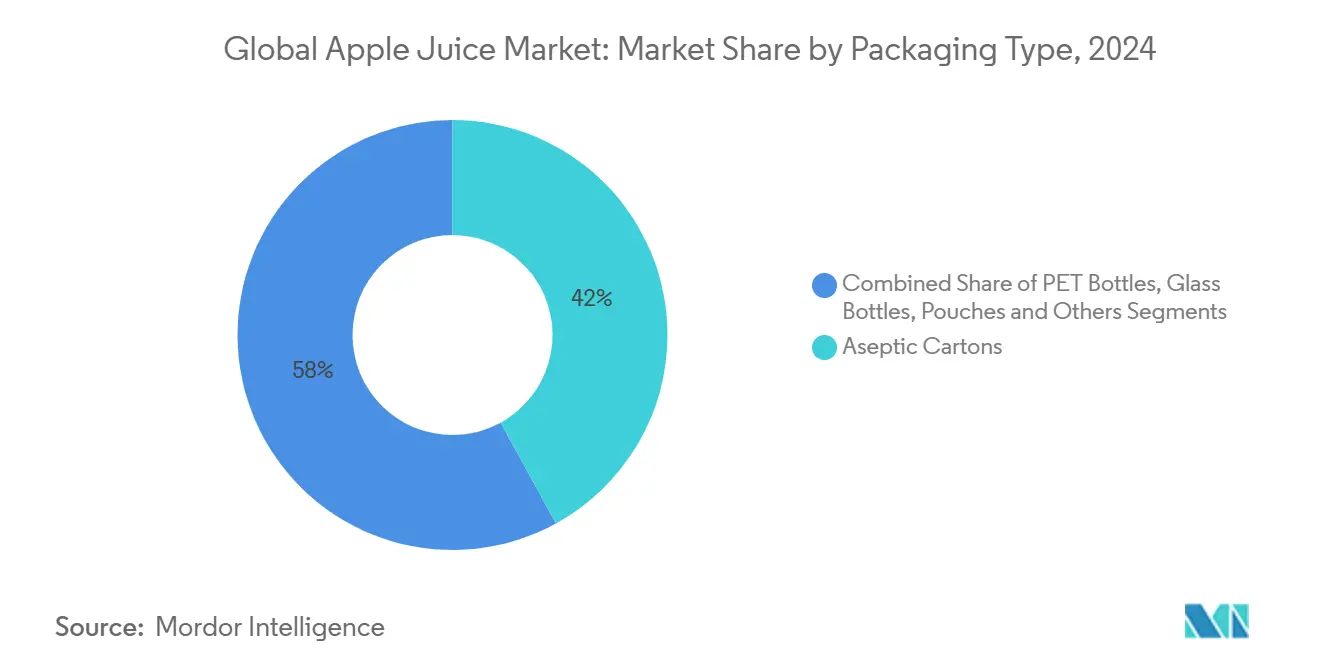
Note: Segment shares of all individual segments available upon report purchase
By Distribution Channel: Foodservice Recovery Drives Growth
In 2024, retail outlets captured 72.30% of sales, with supermarkets, convenience stores, and e-commerce platforms leading the way in offering diverse choices. Meanwhile, the foodservice and HoReCa sectors experienced a 7.10% growth surge, buoyed by a resurgence in travel, catering, and quick-service dining. Retailers, appealing to a broad demographic, employed strategies like price promotions, loyalty programs, and strategic point-of-sale placements to deepen their market penetration. Additionally, retailers are capitalizing on their market dominance to introduce premium and functional SKUs. In line with wellness trends, supermarket chains rolled out private-label cold-pressed and fortified apple juice lines in 2024–2025.
Foodservice is swiftly outpacing retail growth, fueled by a rising appetite for healthier beverage choices in cafés, restaurants, schools, and workplace vending. The International Beverage Association highlights a consumer shift towards single-serve, functional juice options in foodservice, a trend amplified by public health endorsements of nutritious drinks over sugary sodas. In response, 2024–2025 witnessed notable product innovations: chains like Starbucks and Panera incorporated cold-pressed apple juice blends and wellness shots into their offerings, and major school nutrition programs revised standards to feature 100% apple juice in grab-and-go-friendly resealable pouches.

Geography Analysis
North America held 38.40% of global revenue in 2024, reflecting entrenched consumption, premium segmentation, and sophisticated cold-chain logistics. Only 29% of domestic apples enter processing, so the apple juice market relies heavily on imports to balance demand. Recent FDA guidance capping lead at 10 ppb forces processors to upgrade filtration and testing infrastructure. U.S. and Canadian producers alike leverage vertically integrated orchards and juice presses to protect margins against tariff swings and freight inflation.
Asia-Pacific delivers the fastest 6.30% CAGR through 2030. China’s dual role as a top concentrate exporter and rising NFC consumer drives intricate supply decisions; export efficiency was just 33.71% in 2024, implying large latent domestic demand online. Urban Indian and Indonesian shoppers embrace single-serve cartons positioned as healthier refreshments, while Japanese and South Korean retailers favor artisanal NFC lines using local cultivars. E-commerce and last-mile chilled delivery expand category access in megacities.
Europe maintains a steady share on the strength of stringent ingredient standards and category innovation. The revised Fruit Juice Directive now recognises a reduced-sugar class requiring 30% natural sugar removal, creating white-space for membrane-filtration technologies and enzymatic biotransformation processes. A 9.7% drop in apple output to 10.39 million tons during 2024 tightens concentrate supply, raising import needs from Ukraine, Serbia, and the Southern Hemisphere. Sustainability scores and carbon footprinting appear on front-of-pack, influencing purchasing behaviour.
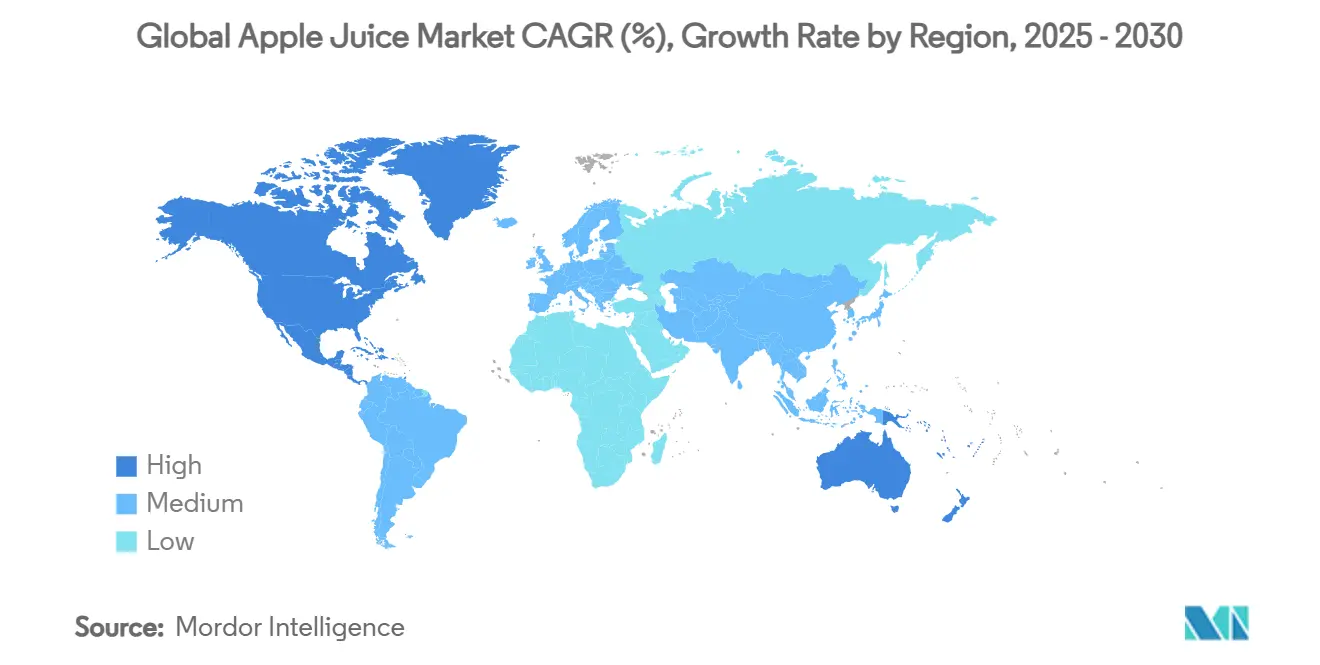
Competitive Landscape
The apple juice market demonstrates moderate consolidation. Global conglomerates such as Coca-Cola (Minute Maid) and PepsiCo Inc. maintain cross-category breadth, cushioning raw-material swings through multi-fruit sourcing pools. Other major players operating in the market include The Kraft Heinz Company, Nestlé S.A., and Tree Top Inc., among others. Market players such as Tree Top and Welch Foods reinforce farmer-owned cooperative models that stabilise fruit prices and ensure steady concentrate inputs.
Strategic responses emphasise functional differentiation, circular-economy processing, and regional expansion. Companies invest in high-pressure processing units and soluble-fiber extraction to capture the gut-health narrative.
Emerging disruptors include gut-health beverage start-ups marketing probiotic, apple-based shots through digital channels. Co-packing alliances give these newcomers scale, prompting established players to form incubators and venture arms. Packaging suppliers such as SIG and Tetra Pak pioneer tethered caps and paper-based straws, aligning brand portfolios with upcoming single-use plastic directives.
Apple Juice Industry Leaders
-
The Coca-Cola Company
-
PepsiCo Inc.
-
The Kraft Heinz Company
-
Nestle S.A.
-
Tree Top Inc.
- *Disclaimer: Major Players sorted in no particular order
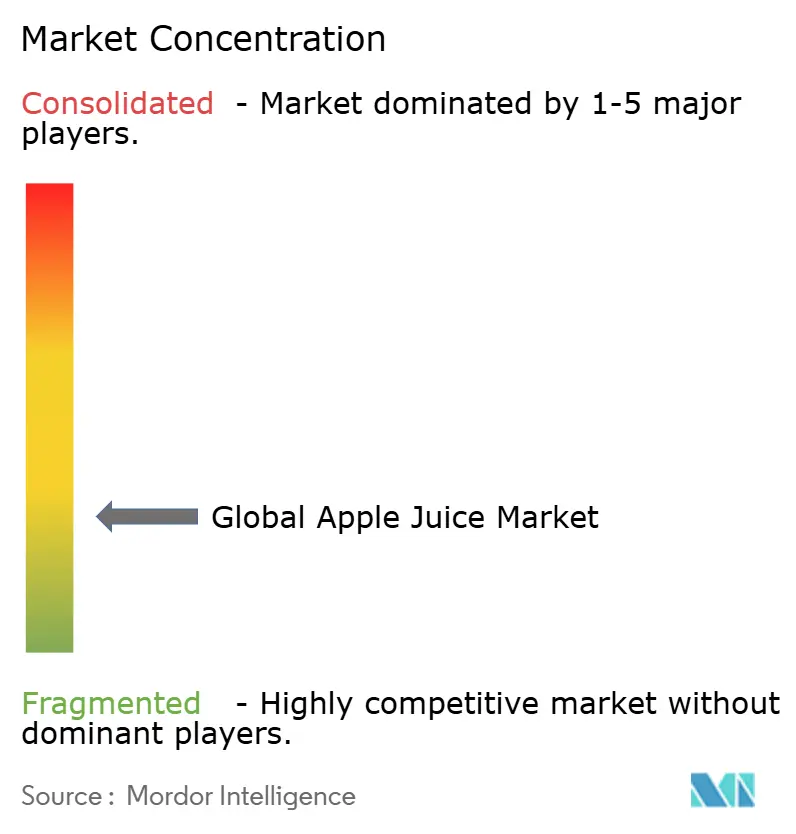
Recent Industry Developments
- February 2025: Trader Joe's launched organic unfiltered apple juice, which features updated organic certification labeling. Made without added sugars or concentrates, this product was asserted to cater to clean-label buyers.
- May 2024: R.W. Knudsen Family launched its carbon-neutral apple juice bottles, fully recyclable glass bottles for organic apple juice. The production process was certified carbon-neutral, aligning with the brand’s sustainability mission.
- March 2024: Martinelli expanded its organic range and launched new variants of organic apple juice with improved cold-chain distribution and direct-to-consumer delivery options in the U.S., reinforcing Martinelli’s position in the premium organic juice segment.
- January 2024: Simply Organic launched cold-pressed apple juice, asserted to be made from single-origin apples. Packaged in glass bottles with minimalist, eco-friendly labels. Targeted at health-conscious and environmentally aware consumers.
Global Apple Juice Market Report Scope
| Concentrate |
| Not-From-Concentrate (NFC) |
| Conventional |
| Organic |
| Aseptic Cartons |
| PET Bottles |
| Glass Bottles |
| Pouches & Others |
| Foodservice/HoReCa | |
| Retail | Supermarkets/Hypermarkets |
| Convenience Stores | |
| Online Retail | |
| Other Distribution Channels |
| North America | United States |
| Canada | |
| Mexico | |
| Rest of North America | |
| South America | Brazil |
| Argentina | |
| Colombia | |
| Chile | |
| Rest of South America | |
| Europe | United Kingdom |
| Germany | |
| France | |
| Italy | |
| Spain | |
| Sweden | |
| Belgium | |
| Poland | |
| Netherlands | |
| Rest of Europe | |
| Asia-Pacific | China |
| Japan | |
| India | |
| Thailand | |
| Singapore | |
| Indonesia | |
| South Korea | |
| Australia | |
| New Zealand | |
| Rest of Asia-Pacific | |
| Middle East and Africa | United Arab Emirates |
| South Africa | |
| Saudi Arabia | |
| Egypt | |
| Morocco | |
| Turkey | |
| Rest of Middle East and Africa |
| By Product Type | Concentrate | |
| Not-From-Concentrate (NFC) | ||
| By Nature | Conventional | |
| Organic | ||
| By Packaging Type | Aseptic Cartons | |
| PET Bottles | ||
| Glass Bottles | ||
| Pouches & Others | ||
| By Distribution Channel | Foodservice/HoReCa | |
| Retail | Supermarkets/Hypermarkets | |
| Convenience Stores | ||
| Online Retail | ||
| Other Distribution Channels | ||
| By Geography | North America | United States |
| Canada | ||
| Mexico | ||
| Rest of North America | ||
| South America | Brazil | |
| Argentina | ||
| Colombia | ||
| Chile | ||
| Rest of South America | ||
| Europe | United Kingdom | |
| Germany | ||
| France | ||
| Italy | ||
| Spain | ||
| Sweden | ||
| Belgium | ||
| Poland | ||
| Netherlands | ||
| Rest of Europe | ||
| Asia-Pacific | China | |
| Japan | ||
| India | ||
| Thailand | ||
| Singapore | ||
| Indonesia | ||
| South Korea | ||
| Australia | ||
| New Zealand | ||
| Rest of Asia-Pacific | ||
| Middle East and Africa | United Arab Emirates | |
| South Africa | ||
| Saudi Arabia | ||
| Egypt | ||
| Morocco | ||
| Turkey | ||
| Rest of Middle East and Africa | ||
Key Questions Answered in the Report
What is the current size of the apple juice market?
The apple juice market size is USD 19.56 billion in 2025 and is forecast to reach USD 26.7 billion by 2030.
Which region holds the largest apple juice market share?
North America leads with 38.40% of global revenue in 2024, supported by premium positioning and integrated supply chains.
Why is NFC apple juice gaining popularity?
Not-from-concentrate variants offer fresher taste and higher nutrient retention, supporting a 7.30% CAGR to 2030.
How are new regulations affecting processors?
The FDA’s lead-limit reduction to 10 ppb and the EU’s reduced-sugar directive require investments in filtration, testing and sugar-removal technologies.
What packaging format is growing the fastest?
Flexible pouches are expanding at an 8.12% CAGR because they reduce material usage and suit on-the-go consumption.
Page last updated on:
